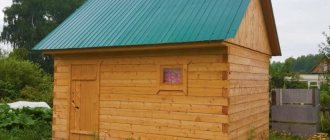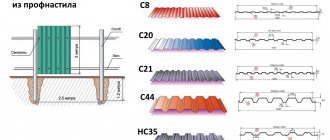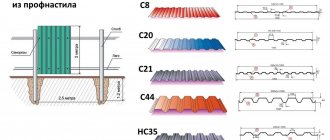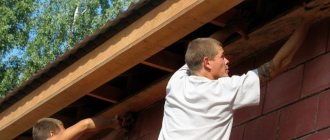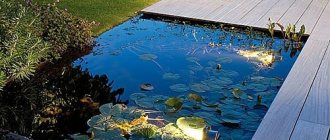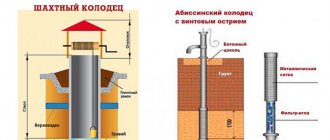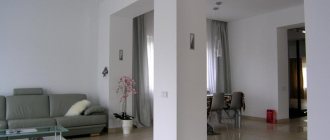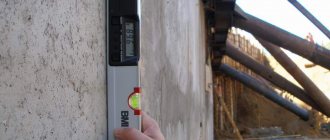- home
- Construction and renovation
- Plumbing
>
>
⬎
Much has been said about the relevance of installing meters for cold and hot water, and as a rule, no one doubts the obvious savings. In this article we will talk about installing water meters yourself. We will not bring to your attention various “husks” about how to choose a meter, how difficult it is to draw up documents and other heresy...
We will share with you the real experience of plumbers who know everything you need to know about this procedure. This will help you perform all the necessary operations yourself, without turning to specialists. The only thing that is required of you is straight hands and at least a little experience in working with them.
Is it possible to install water meters in an apartment or private house yourself?
The law does not prohibit installation work on installing hot and cold water meters yourself.
On July 1, 2013, Federal Law No. 261 on the mandatory universal installation of water meters came into force.
If the average person decides not to involve craftsmen, there is an opportunity and desire, then there is no clear wording of the prohibition in this Resolution.
There are certain nuances, the observance of which will protect the private owner from mistakes and troubles:
- The purchase of metering devices is carried out only in specialized companies that have a license. Each meter must have a technical passport.
- The quality of installation work is checked by Vodokanal services or special organizations authorized to verify metering meters.
- On the day of installation, a necessary condition is to turn off the water supply through the riser on all floors of the building, agreed with the residents and the building manager of the high-rise building;
- After installing the devices, all possible problems (malfunction, leakage) are resolved and compensated at the expense of the apartment owner.
If the above conditions are not met, the water utility has the right:
- do not allow water meter registration;
- if there is a risk of an emergency, dismantle;
- fine the unauthorized installer.
Important! When installing hot and cold water meters without skills, it is better to use professional repair and maintenance services.
To avoid unpleasant moments, neighbors are warned in advance about temporary inconveniences when the water is turned off.
Is it profitable to install a meter?
Many Russians still cannot decide whether it is profitable to install a water meter. The main difficulty is that such a step is not very beneficial for citizens living alone. As a result, you will have to pay more than if you did not have a measuring device. This option is convenient for people who often leave for a long time or when there are more people living in the premises than registered.
The minimum savings when installing a metering device can be from 30%, but most often the amount is reduced several times. For information, it should be noted that the consumption standard per person can be 8-10 cubic meters. In fact, water consumption can be much less - up to 5 cubic meters.
Based on this, the decision to install meters will allow you to significantly save on rent. If there are regularly more people on the premises than registered, then this option is not suitable for saving.
Pros and cons of self-installation
The advantages of self-installation are obvious:
- saving money on installation of devices;
- the ability to determine the date and time of installation at a convenient time for the owner of the apartment or house;
- independent choice of metering meter model based on ratings and reviews.
Disadvantages of DIY installation:
- risk of poor-quality installation of metering devices;
- increasing the likelihood of an emergency (especially in an apartment building);
- double costs associated with forced dismantling and re-installation of metering devices.
The owner must make a conscious decision: calculate the pros and cons of “home” installation of a water meter for hot and cold water consumption.
3.5. Drawing up a certificate of registration of a water meter
The act of registration or commissioning is an integral part of the previously drawn up agreement between the service provider and the subscriber.
This document states:
• date, month, year of commissioning;
• service provider, in this case, the organization supplying water;
• details of the specialist who carried out the installation and/or inspection and who drew up this report;
• consumer (owner) data;
• installation address;
• identification number, marking, model;
• indications;
• license plate seal;
• if the meter was previously installed, it is necessary to indicate the data of the last verification, including its date.
The act is drawn up in two copies. This document must be kept for the entire period of use of the meter.
Principles for choosing a metering device
In order not to make a mistake before purchasing a water meter, you need to take into account the accuracy class of the device . The accuracy of water flow measurements depends on it, but the cost of the water meter will be higher.
Which one should I buy for DHW?
When purchasing a device for domestic hot water, most often the choice is made on tachometer devices.
Turbine models are used for pipelines with a diameter of 50 to 200 mm. For narrower sections (up to 40 mm), vane meters are used.
We advise you to adhere to the following features:
- pressure in the device is from 16 atmospheres or more;
- operating heating temperature range from 5 to 150 degrees Celsius;
- maximum sensitivity is equal to the average hourly passage of a volume of water;
- The permissible error should not exceed 5%.
On a note! The metering device must bear the manufacturer's seal. The technical passport contains the device number, test date and QC stamp. The seller adds information about the date of sale and the seal of the seller-store to the details.
ITELMA WFW20.D110
In terms of reliability and technical characteristics of mechanical meters, ITELMA WFW20.D110 (a joint German-Russian brand) is in 1st place.
Advantages:
- 6 year warranty;
- affordability.
"DecastMetronic" VSKM 90-15 DG
The vane water meter is convenient for main pipelines with low energy consumption.
Advantages:
- 10 year warranty;
- easy to repair;
- simple design.
The main disadvantage is that there is no mounting hardware for installation.
Zenner ETWI-N DN 15
The German model is one of the best mechanical universal water meters. The device uses a multi-jet operating principle.
Advantages:
- high build quality;
- accuracy of flow measurement;
- there is a function for transmitting values via Wi-Fi;
- long term - 12 years.
The only drawback is the price is higher than average for water meters.
It is recommended to take into account individual characteristics:
- what is the state of communications;
- approximate composition of water (hard or soft);
- availability of funds for purchase;
- indicators of heating water entering the system.
To assess financial capabilities, it is better to check with special organizations the approximate cost of installing equipment. Installing a water meter on your own is a troublesome and responsible undertaking.
Which one to buy for cold water supply?
Main characteristics of the cold water meter: temperature range up to 30 degrees Celsius. A distinctive feature from the GW device is the calibration interval. The difference will be in the timing of verification; usually a hot water meter requires more frequent verification.
For a water meter for cold water, the interval is 6 years, for hot water - from 4 to 6. High temperatures wear out the meter parts faster.
The color of the housing differs; for cold water, blue ones are often used; for hot water, a red meter is required. The diameter of the pipeline is taken into account, options are possible from the minimum (15 mm) to the maximum - 20 mm.
Important! When installing a water meter, the following rule is followed: a meter designed to measure the flow of cold liquid is placed on a cold pipe. It cannot be used for hot water!
Betar SHV15
In terms of operational capabilities for cold water, the Russian Betar SKHV15 meter is distinguished. There are three installation options: vertical, horizontal or at an angle. Permissible liquid temperature +5….+40 degrees Celsius, maximum pressure 10 Bar.
Advantages:
- with warranty 6, the service life can reach 18 years;
- low cost;
- convenient to install and operate.
NORM SVKM-25X
More expensive in price, but optimal in performance. It deservedly ranks 1st among premium models.
Advantages:
- brass body with anti-corrosion coating;
- compact, easy to install;
- there is magnetic protection against interference with the operation of the device;
- pulse output.
Practice shows that it is better to choose tachometer models for an apartment or private household .
They have an optimal balance of cost, quality, and ease of use.
Sealing
The legislation of the Russian Federation determines that sealing of meters should be free during the initial installation of devices , as well as after a scheduled inspection or repair.
Keep this in mind if the inspector suddenly wants to mislead you. He is obliged to seal the unit free of charge and document the process.
For re-sealing you will have to pay from 500 to 2000 rubles (depending on the drawn up contract), but this amount will be much lower than what you will be required to pay if damage to the seal is discovered by an inspector during a routine inspection.
Differences in mounting DHW and cold water devices
It is permissible to install a DHW meter on a cold pipe; in other words, it is permissible to install two red ones for hot and cold water.
Note the advice of practitioners! You can install both red meters, but for convenience it is better to separate them so that there is no confusion when collecting readings.
There are houses in which the hot water supply system operates according to a two-pipe system. To install a water meter on a hot water supply, you need a bypass valve. Otherwise, the meter will count excess water consumption.
For cold water meters, rubber gaskets are installed; for domestic hot water, the private owner must buy paronite gaskets.
Shut-off valves and features of technical work
A shut-off valve must be included with the meter. If it is silumin, then care must be taken, because it is susceptible to destruction due to corrosion, and it is quite difficult to quickly turn off the water. A metal-plastic faucet is more suitable for use. It is best to immediately purchase a spare set.
Features of working with the counter are as follows:
- If there is a fire water drain, you will need to install a valve, which the water utility will subsequently seal;
- When assembling a hot water meter in an apartment with a domestic hot water system, you will need to purchase a bypass valve.
After installing the meter, a seal must be installed.
The temperature level should not be lower than +5 ° C, otherwise you will have to explain the situation to the water utility.
How to install correctly: step-by-step instructions
Before starting installation work, the private owner needs to write an application to the local Vodokanal office.
After receiving the technical specifications for the water meter, a model is selected and an metering device is purchased. They check the presence of the certificate and seal impressions.
It is necessary to have water meters checked by the Vodokanal management, private licensed companies or the Housing Office.
The meter is left with a technical passport, in which, upon successful verification, all fields are filled in and the organization’s stamp is affixed. Indicate the day of the upcoming seal on the device after installation is completed.
The meter has an instrumentation - seal. Its safety is a guarantee that the water meter will be accepted by Vodokanal. There are situations when the plant seal is broken, the water meter will be taken to the instrumentation, but without the latter’s seal the indicator data will not be taken into account for calculation.
The principles of installing a water meter in a private house and apartment are largely similar. Let's look at them.
Mounting kit
To install the device you need the following parts:
- Stopcock. Brass ball ones are more often used, if the pipeline is made of propylene, a plastic tap is installed. It must be new and of high quality to eliminate the risk of failure. The private owner must control the position of the shut-off valve. Two positions are allowed: “open”, “closed”. If it is not fully opened, it will quickly wear out and fail.
- Water purification filter with a mesh for large contaminants. There are two types - right angle and oblique. Periodically, the mesh needs to be cleaned of accumulated dirt.
- Check valve. So that the device does not start to “wind” back in a situation where the water supply to the system has stopped.
- Water meter.
For installation, the private owner independently purchases a check valve for each pipeline. To make the connection airtight, sealing materials are needed.
It is more convenient to use TangitUnilok threads with lubricant made from silicone, paste, or flax, tow. Connecting elements - fittings - will be required to make the transition from metal to metal-plastic.
Special tools required:
- scissors for cutting pipes made of metal or polypropylene,
- “iron” for welding joints and a set of keys.
If work is carried out with metal pipes, you need a grinder and equipment for cutting threads.
How to determine the location?
There are general rules for choosing a location:
As close as possible to the point of pipe entry from the main. The site is chosen horizontal to prevent water intake past the device. The place of attachment is determined so that the inspection services do not have unnecessary suspicions.- In an apartment, a meter is often installed near the toilet; if pipes pass inside the floor structure, the water meter is mounted in the bathroom.
- For private housing construction, the water meter is installed near the outer wall at a distance of no more than 200 mm from the exit point of the pipeline.
- If there is a well in the area with a pipe leading out from the main, a major installation is carried out. The well is covered with a lid (metal) and sealed. Unsealing is possible in case of fire or emergency. In other options, the seal is removed only in the presence of an official from the Vodokanal.
The water meter will be able to give correct readings if the risk of turbulence flows is reduced. Before the counter 45 mm, after - 15 mm. It is mandatory to install a valve in front of the metering device to shut off the water supply.
Installing a water meter
After purchasing all the necessary parts and components, proceed directly to installing the water meter.
The installation procedure includes:
- It will be easier if all the parts are lined up in one line , starting from the check valve and ending the chain with a shut-off valve. The manufacturer provides arrows, check that their direction is the same.
- It is recommended to make a “dry” connection in order to calculate the number of turns in advance. Usually there should be up to 5 pieces. During installation, remember the position of each element. Then they unwind it, take the sealing material, and wind it onto the faucet filter with the required number of turns. The sealant is placed so as to cover the entire thread.
- Shutting off the water supply . It is necessary to completely turn off the liquid supply through the main water supply. If it is not possible to close the outlet from the riser, it is necessary to block the flow of media through the cold and hot water risers.
- After completing the connection of all elements, insertion is carried out . For an apartment building, you need to call an inspector from Vodokanal in advance. The installer measures the length of the structure. An equal distance is cut off on the pipe; it is better to place a water container at the bottom.
- Fastening the structure to the pipe. If the pipe is made of metal, you need a thread and a clear measurement of the length to cut the excess section. It is easier to mount the meter on polypropylene pipes. Additionally, fittings are required to make connections between different materials.
Visual installation instructions can be seen in the video:
Direct installation is not so complicated and does not require time. The most difficult thing is to go through all the approvals and obtain documents for permission to install water meters.
3.4. Sealing
You won’t be able to install a meter and pay according to its readings right away. It must be registered with a special control service.
Sealing procedure:
• submit an application to the water utility about the need to install a seal;
• determine the time of the inspector's visit;
• provide the inspector with the meter and documents specified in clause 6 on the specified date;
• sealing is carried out;
• the commissioning certificate is filled out.
After this sequence, official procedures are completed and the counter is considered valid.
If a water filter is installed, the order of the devices is as follows:
• tap;
• filter;
• counter.
In this case, the filter is sealed together with the meter.
What to do after?
The final stage after installation is a mandatory performance check. To do this, perform the following steps sequentially:
- turn on the water supply;
- gradually open the ball valve;
- check if there is a leak.
If everything went without a water leak and the meter is working normally, they call a Vodokanal inspector . After the inspection, the water meter is sealed, registered and marked in the device’s data sheet.
The private owner must receive a document confirming the acceptance of the device into operation, a technical passport with a mark on the date of the seal. Calculations of meter readings are carried out from this day.
You cannot install the seal yourself or invite private craftsmen . The sealing procedure is carried out after an official application for acceptance of the device for measuring water flow.
Important! Until registration has been completed, water meter readings cannot be taken to calculate the cost of water supply services. It is better to do the procedure immediately after successful testing of the metering design.
How is data transferred through the meter?
After the meter is installed, it is necessary to take readings from it every month and transmit the information to the destination. In different regions, the procedure for transmitting information may be organized differently, but, in general, the action is standard.
There are several ways:
- indicate data in the receipt for payment of charges for the current month;
- leaving information in your personal account on the water utility website;
- transmit information by telephone.
There are other methods from which the citizen himself chooses the most convenient and acceptable for himself.
Requirements for installing water meters
To avoid errors and problems, you should follow the following recommendations:
- Installation of only certified products is allowed. The manufacturer must independently carry out the first verification of the device and record this in the passport. Additionally, water meter numbers and seals are applied to the housing, which confirm the suitability of the IPU and exclude changes to the design.
- The apartment meter is located in a room that serves to supply supply pipes. If there are several points, as happens when there are systems in the kitchen and bathroom (WC), then the devices are installed in both rooms.
- In private houses, the IPU can be placed in the basement, but if the main line is long, the meter is installed before the entrance to the building. A special well is made for this.
- The minimum temperature at the location site is not lower than +5 degrees.
- The selected location should be convenient for checking the functionality of the product.
- The installation of the mechanism in the water supply system is carried out according to the standard scheme; a coarse filter must be installed in front of the meter. It has a simple configuration and allows you to trap large debris. This not only guarantees the safety of the device, but also prevents violations of the recording of readings.
- The IPU cannot be placed far from the site where it is inserted into the main system (riser); the distance from the starting point to the installation site should not exceed 20 cm. Exceptions are possible only in special cases.
- Water meters must be registered and sealed. Indications from a mechanism that has not been put into operation are not subject to recording.
For installation, it is recommended to involve specialists or obtain detailed advice from a service company in advance.
Verification
Verification of water meters is carried out by metrological organizations of the state and private property systems. You need to carry out periodic verification yourself, involving specialists.
The planned one is carried out 6 years after installing the water meter for cold water and after 4 years for hot water.
Unscheduled verification is carried out only if there is a suspicion of incorrect display of water flow or breakdown.
How to install a thermostat for a heating radiator, read here.
What are the basic requirements for a chimney for a gas boiler? Let's take a closer look at the rules of arrangement and building codes.
Verifications are carried out in two ways:
- with dismantling of the device and subsequent delivery to the inspection organization
- with a call from a specialist - at home, i.e. without removing
In the first case , special permission is required to remove the device. The inspector must come and record the readings of the device and give you the relevant documents. You deliver the water meter and pick it up yourself. Then installation and again paperwork with calling the inspector.
If the device does not pass the test , you will still need to pay for it and worry about purchasing and installing a new one. The minimum cost for everything is 1250 rubles.
In the second case , verification is carried out by a service employee on site using a portable verification stand. The cost of the procedure is much lower (500–600 rubles).
The downside is that the quality of work is checked by a device that, using high-precision scales, weighs the water passing through the water meter. Internal damage and wear of parts cannot be detected in this way.
To learn how verification is carried out at home without removing meters, watch the video:
In some regions, verification of water meters has been canceled and is therefore illegal. We advise you to check the information for your region with the Management Company or Vodokanal.
